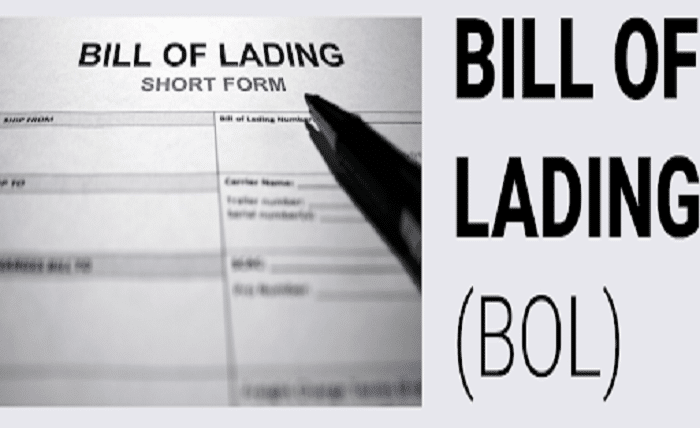UNDERSTANDING THE ESSENTIAL ELEMENTS OF A BILL OF LADING: A CRUCIAL DOCUMENT IN SHIPPING

A bill of lading or BL is an official document that a carrier provides to the shipper. It is a legally binding record that contains vital information, such as the quantity, type, and destination of the goods being shipped. It acts as a receipt and confirms the shipment while serving as evidence of the agreement between the shipper and the carrier.
This document ensures that all parties know the shipment details and their responsibilities.
What is included in the bill of lading?
1. The purchase order and account number – field is a repository for the exclusive identification number provided to the consignment. This number aids in monitoring and arranging the shipment and establishes a connection between the shipment and individual transactions or accounts in the sender’s or receiver’s systems.
2. The date of shipment refers to the day the merchandise is delivered to the carrier for transport. This information is crucial for establishing deadlines, arranging appointments, and tracking the shipment’s advancement.
3. Shipper’s name and address- The segment about the shipper’s details encompasses the name and address of the individual or organization accountable for the commencement of the consignment. This section facilitates accurate identification of the shipper and furnishes crucial data for communication and documentation.
4. The recipient’s name and address are crucial details identifying the intended party receiving the shipment. These details are vital in ensuring the accurate and timely delivery of goods by specifying the precise destination.
5. The number of units being shipped denotes the overall quantity or count of individual units that are a part of the shipment. This field plays a vital role in ensuring the completeness of the shipment and acts as a point of reference for managing inventory.
6. Description of what’s being shipped– The following segment comprehensively depicts the dispatched merchandise. It encompasses particulars about the articles’ essence, class, attributes, and technicalities. Such information aids in recognizing and administering the shipment fittingly during transportation.
7. The declared value of shipped goods is the monetary worth of the shipment. This figure holds significance in insurance and governs the carrier’s responsibility in the event of loss or harm to the shipment. The bill of lading often includes a section where the declared value of the goods is indicated.
8. Shipment packaging refers to the method of packaging utilized to safeguard and preserve the merchandise throughout the shipping process. This may include various containers such as cartons, crates, pallets, and others. Its objective is to promote appropriate handling and guarantee that the merchandise stays in good shape during transportation.
9. The mention of hazardous materials by the Department of Transportation indicates that specific measures and precautions are to be taken during the transportation of such materials. This ensures adherence to safety regulations and safeguards those responsible for transporting, handling, and the environment.
10. The National Motor Freight Classification (NMFC) offers a uniform classification system to categorize freight based on physical attributes, handling needs, and potential risks. This system provides an NMFC code that helps determine suitable freight charges and guarantees harmony among carriers and shippers.
11. Exact shipment weight denotes the accurate shipment weight, usually measured in pounds or kilograms. This information is crucial in determining shipping expenses, evaluating load capabilities, and complying with transportation regulations’ weight constraints.
12. Pickup or delivery specifications provide explicit guidelines and stipulations regarding the collection and distribution of the consignment. It encompasses details such as the preferred pick-up times, delivery time frames, exceptional handling instructions, and other relevant information that necessitates communication with the carrier or receiver.
What are some of the types of bills of lading?
1. The Straight Bill of Lading or consignment bill of lading is for pre-paid goods or those not requiring payment on delivery. The consignee only needs ID to get the cargo, and the delivery terms are fixed. It becomes a non-negotiable receipt on delivery. This category has sub-categories.
2. The Short Form Bill of Lading is a type of bill with no terms and conditions printed on the back, also known as the blank back bill of lading. It’s not commonly used because customers prefer having all the details in writing for safety. However, the courts will add the back clauses as a matter of practice since it’s a shortened version of the full straight bill of lading.
3. A blank endorsed bill of lading is a non-endorsed document that needs the consignee’s name, making it a straight bill of lading. It becomes negotiable only when filled in or endorsed. Blank endorsement allows transfer to any party without restrictions. This bill permits ownership claims, transfers, and deliveries to new recipients. Its negotiability allows transfer without limitations.
4. An onboard bill of lading proves that goods are loaded onto a ship and ready for transport. It is vital for buyers, sellers, banks, and insurers as it confirms the shipment and serves as evidence. Banks use it to finance the goods in transit. The on-board bill of lading is critical in international trade.
5. The ocean bill of lading is necessary for cargo crossing international waters. It acts as a receipt from the carrier to the shipper and includes details like packaging and cargo value. The carrier and shipper must sign the contract before the receiver can sign the document.
6. The Inland Bill of Lading is needed when cargo is transported by land before crossing international waters. It allows materials to reach the shore before being shipped to another country. The ocean and inland BoL are required to export cars in various cases.
7. Multimodal bills and through bills of lading are used for transportation. Multimodal bills cover land and sea, while through bills cover only one. MTOs issue multimodal bills and are accountable for the cargo during the journey. Carriers give through bills and are responsible only for the carriage part. For successful shipment, two modes of transportation are required.
Summary –
Amazon Global Selling offers reliable logistic support and a bill of lading for shipping overseas. It’s an excellent opportunity for businesses to expand their market reach and increase revenue.




